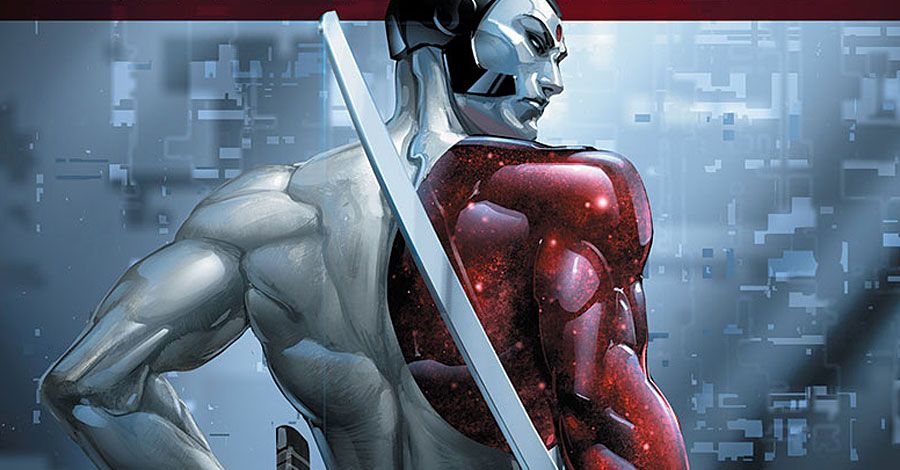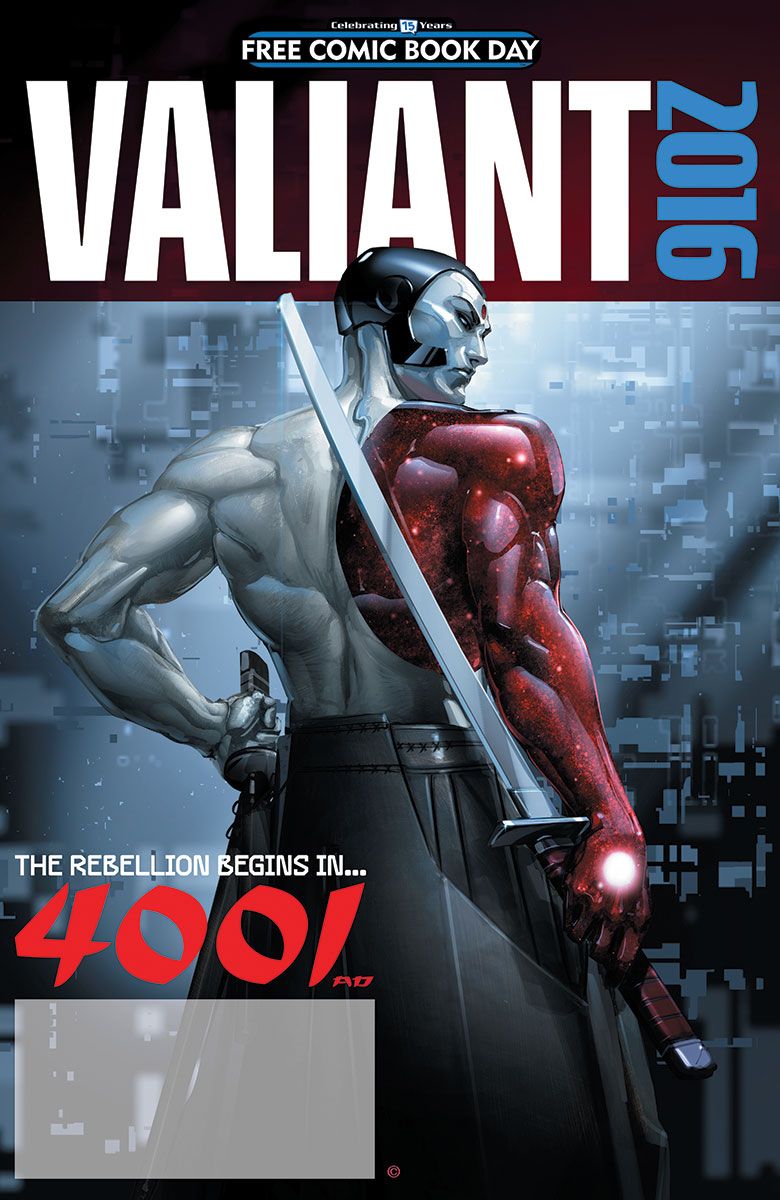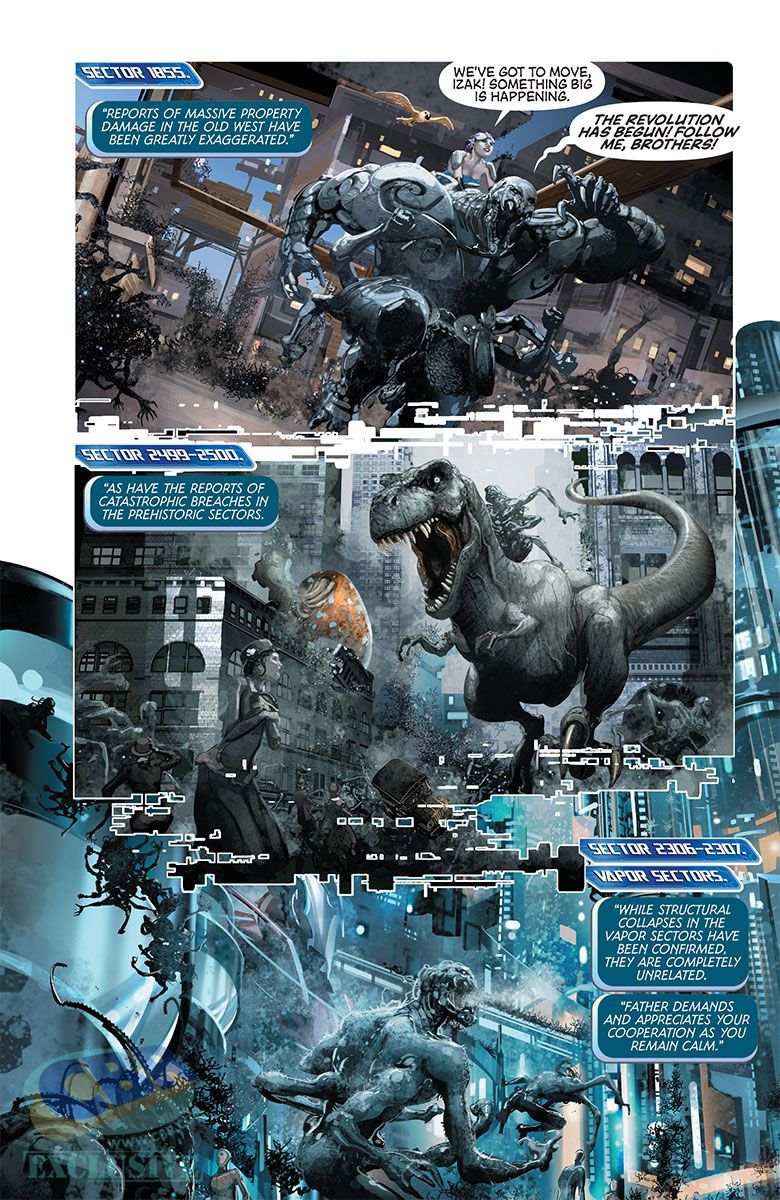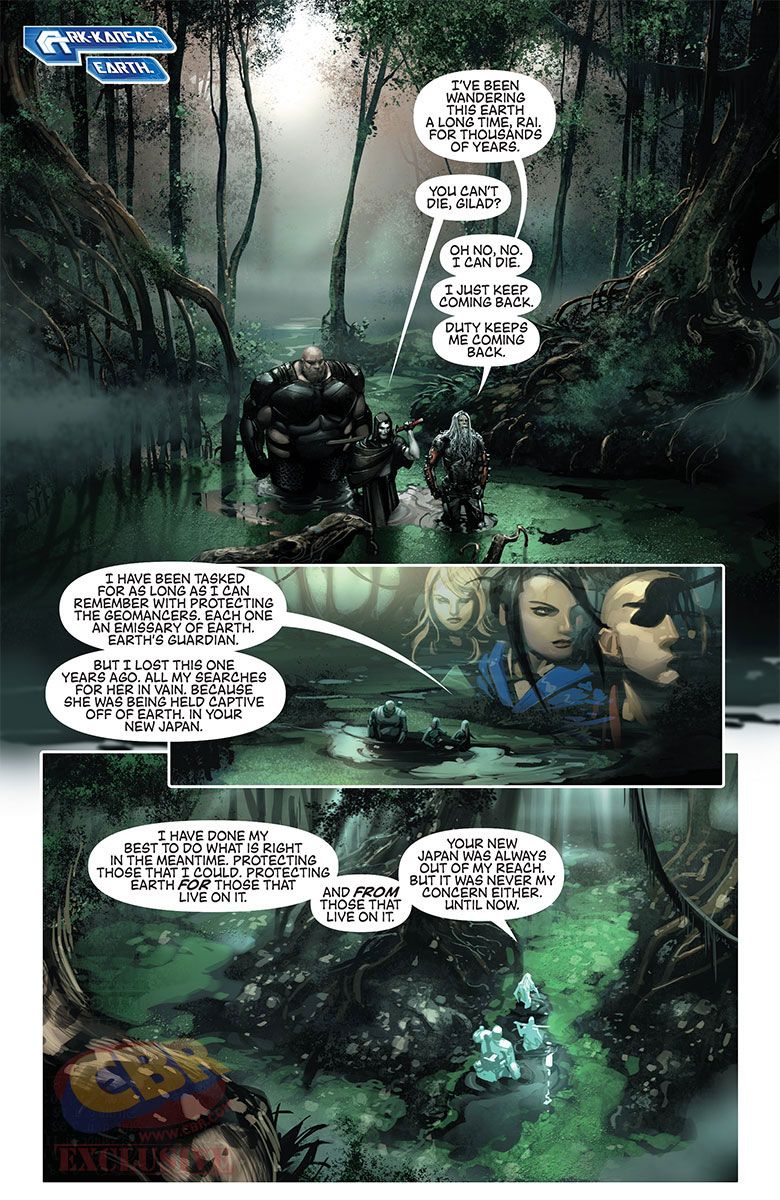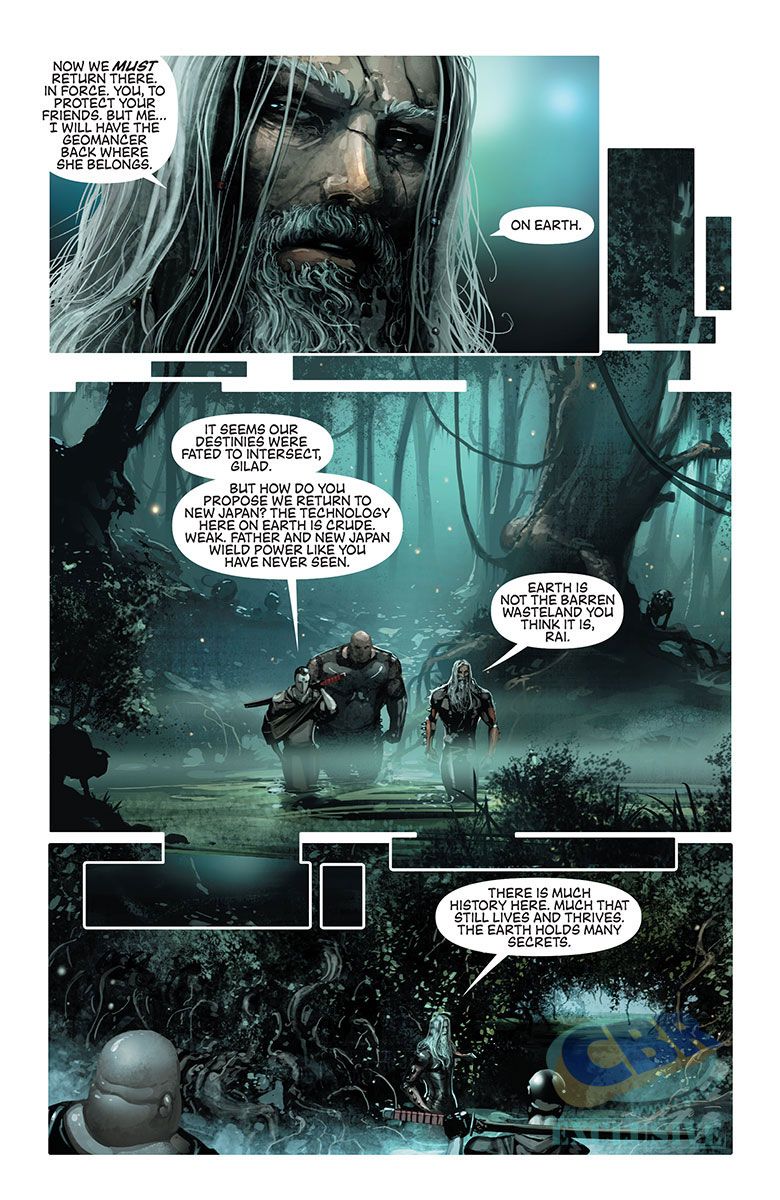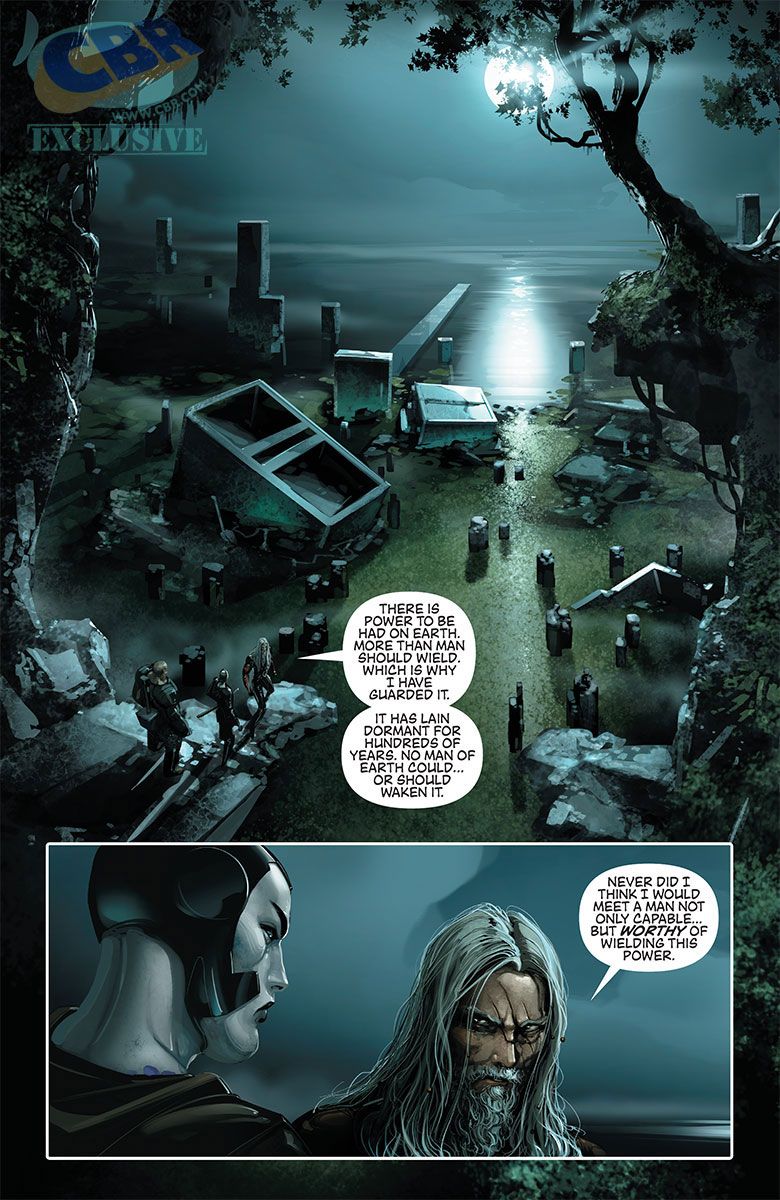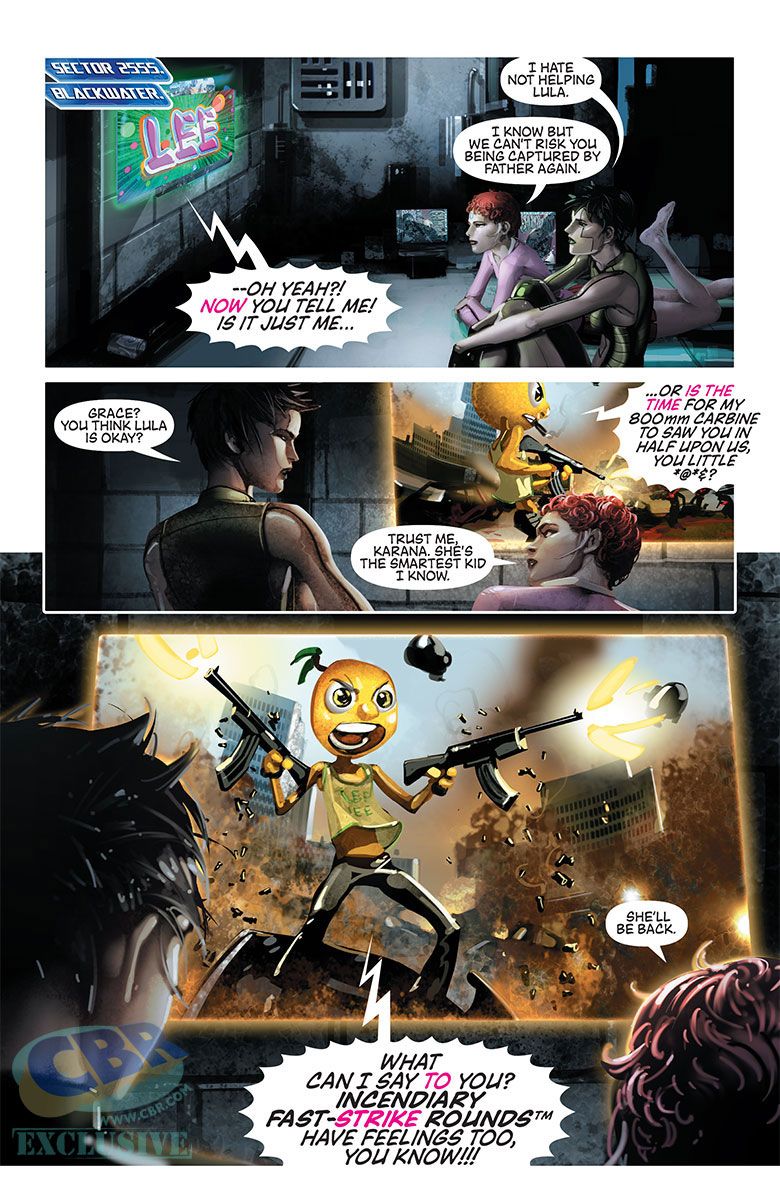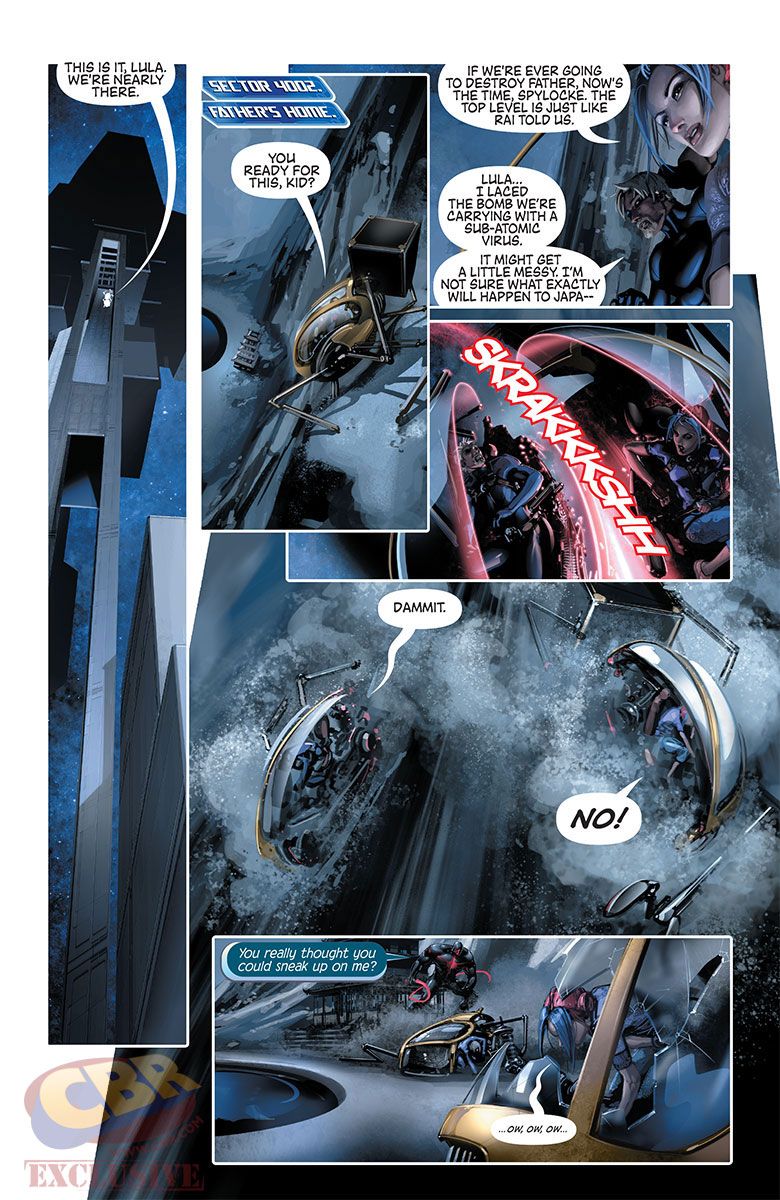Following in the footsteps of "Harbinger Wars," "Armor Hunters" and "The Book of Death," "4001 AD" arrives in 2016 as Valiant Entertainment's next major event. Creative team of Matt Kindt and Clayton Crain take readers millennia into the future of the Valiant Universe, and picks up on the duo's work on "Rai" with a giant crash of a rebellion which finds the hero of New Japan attempting to bring down the corrupt leadership of Father, once and for all.
It may sound complicated, but don't worry -- the event is planned as a fresh jumping-on point for readers who are new to the Futureverse side of Valiant. Because this shared universe is built unlike most others, as it all runs on one interconnected, rippling timeline. Valiant tells stories set in the past, the present and -- as seen here -- the future, and you only have to read the ones you want. "4001 AD" will find the heroic Rai setting up a rebellion against a somewhat fascist dictator who founded a country, dubbed New Japan, which orbits Earth. All he has to do -- is find a way up there.
It's a political thriller, with huge amounts of sci-fi (and punching) from a creative team who have created a universe aside from the universe in the ongoing "Rai" series. To learn more about the event, CBR News spoke exclusively with writer Matt Kindt and Editor in Chief Warren Simons about the company's next big event, which kicks off in Valiant's Free Comic Book Day offering on May 7, 2016, before "4001 AD" #1 arrives later in the month.
CBR News: I wanted to start off by talking about "4001 AD" as a general concept. What is so important about the year 4001 for Valiant?
Warren Simons: I think one of the amazing things about the Valiant Universe -- especially in its original incarnation -- was that it was always the Universe which had a very robust past, present and future. Things that happened in the past affect the present, things that happen in the present affect the future, and you can see ideas move across multiple timelines. Obviously, whilst we try to make all our storylines as accessible as possible for new readers, long-term readers can spot how different parts of the timeline affect one another and recur in storylines.
Matt Kindt: As a fan of the books back in the day, and as a creator now, the thing that always appealed to me was considering the ripple effects throughout time and how they expand out. That's something which has always fascinated me, throughout fiction, and particularly with the Valiant Universe. The characters here feel unique, and it's really interesting how we can actually see how some of them are still around in the year 4000.
And it doesn't feel contrived -- it makes sense from a storytelling sense that some of them are still around. At least three characters are immortal! So we know they're still around, and in the year 4001, we get to see what they're up to.
Rai as a character and as a series is quite important. What's been going on in the main "Rai" series as we lead up to "4001 AD?"
Kindt: In the last arc, we left with Rai being thrown down to Earth. He's been in conflict with a figure known as Father, who is the architect of New Japan, which he runs with an iron fist.
Simons: And just to catch up new readers -- New Japan is a country which orbits the Earth. It's ruled by Father, who is an autocratic dictator. The "Rai" series as a whole has been about seeing this conflict in Rai, as he begins to realise that all is not well in his home, and he stands up against Father's fascism.
In the series, Earth has become this desolate landscape, which is so bad, that -- what's the curse they say, Matt?
Kindt: "Earth" has replaced "Hell" as a curse -- that's one of the worst words they use!
Simons: So future Earth is now this synonym for Hell, which is pretty great. It's uninhabitable, and that's where we pick up the pieces for Rai after issue 12.
Kindt: Rai was beaten by Father and thrown down onto Earth, leaving behind all his friends and allies. Rai has to try and figure out what his role can be now -- how can he recover and get back up to New Japan, and beat Father?
He's also lost all his powers. So, without too many spoilers, he's going to meet The Eternal Warrior, who may have a way of helping Rai. They share a common goal of getting up to New Japan -- because the Eternal Warrior has just learned that the new Geomancer, who he has sworn to protect, is living up there. We end things in "Rai" with them heading back up there for a big final confrontation, which we'll see in "4001 AD."
So is this a bit like a futuristic team-up book? A rebellion against the dictator and his cause?
Kindt: Yeah. If anything, it's funny, because this big event came about as I pitched for "Rai," the series. I always had the idea that I would start out small on "Rai," and let things grow. We start small on each arc, but then pull back just a bit to show more for the readers. So we see New Japan, and then we pull back to show that it orbits around the abandoned Earth. Everything seems like a utopia on New Japan, but then we pull back and see that Father hasn't always been there for Rai, and that he's been lying to Rai, and we see this fight back begin for Rai. But then we pull back even more to show that this battle is happening all across New Japan, as various others are fighting back against Father, too!
When we get to issue #12, and then to "4001 AD," it's pulling back further to reveal more about New Japan, as well as everything that's going on, on Earth. How does New Japan affect Earth, how does Earth affect New Japan? It's all about pulling back that surface. With this event, we're pulling away from just Rai, as well, and revealing the whole Valiant Universe as it stands in the year 4001.
If Rai's building a rebellion, he has to stand up for himself and be this leading voice. This is an unfamiliar situation for him -- how does he handle it?
Kindt: In a lot of ways, for me -- and I never go into a story thinking, "What's it about?" Because I like to see the story reveal what it is -- in a lot of ways "Rai" has become this coming-of-age story. He's literally kicked out by his Father and forced to grow up, decide who he wants to be and how he wants to live his life -- and then he has to have this confrontation with his parent figure, who is actually kind of terrible.
Simons: One of the joys has been to watch Matt build up on the characterization and see Rai grow up in a very tough household! He finds he has to take on this new role when he finds out how bad things actually are.
Kindt: Will he get resolution, or will he just go off and leave? I think he's been burnt before by thinking he's a hero before then realizing he's not, and now he wants to take on the hero role again. That's his struggle.
One thing that's been particularly interesting with the series is your collaboration with Clayton Crain. After the first arc finished, Valiant paused a month or two in order to make sure he could also illustrate all the second arc. How important has his style been to establishing 4001 as a whole?
Kindt: I think it's so important. This wouldn't be what it is without him. What he brought to the series is so much more than I could put into a script. We've developed this great collaborative working relationship -- we talk on the phone a lot, and I make sure to include him on a lot of the story, get ideas from him and tailor towards things he's interested in and likes to draw. Superstitial stuff, but also in terms of design -- he pours so much into the pages that he'll give me extra ideas, and things can grow out of that. Of all the comics I've worked on with someone else, this has definitely been one of the closest collaborations.
Simons: He's absolutely a visionary artist. You can't understate the contributions he'd made to this book and Universe. 4001 would have such a different tone and vibe without him. Particularly, I think his digital painting is able to capture so much of the high concept of this universe -- it feels like you're in the year 4001. It's like when you watch "Blade Runner" for the first time, it feels futuristic, and Clayton brings such a huge amount to the book in that vein.
At the end of the day, it's hard to extract what ideas came from who, and Clayton's extraordinary -- he did the design for all the Armor Hunters over in that story, and he designs almost all the characters who appear in this book too. The way he interacts with the environment and renders the script is perfect.
In your other series, "Ninjak," you draw up designs for his tech on the first page of each issue -- but the notes and descriptions for the technology basically described Ninjak as a person, at the same time. Do you get involved in the design and concept of the tech we see in Rai, in the same way?
Kindt: Technology is a thing he's really struggling with. He has this technological connection to Father, where he can dissolve and then reappear, and use this crazy power -- but then he loses that. In a way, he's been stripped of all his technology, and that really informs how he looks. He's changing, and that reflects how he's changing as a person, also.
I feel the look of a character is always driven by their personality, or should be, in many cases. They're so integrated that you can't separate them. I tend to draw designs alongside my scripts just for myself, but I barely do that with Clayton at all! I don't want to poison the well with my ideas, I just want to see what he does with it.
How do you see the differences between New Japan and Earth? We haven't seen much of Earth until recently, have we?
Kindt: I was talking to you just last week about this, Warren, and how New Japan is split into sectors. It's a little like New York, only it has recreation sectors, and that kind of thing. I guess I don't know if it ever made it into the scripts, but my thought has always been that it's a sign of nostalgia. It's humanity missing itself, and unconsciously trying to recreate that. I feel that's what New Japan represents -- humanity trying to recreate itself, and protect itself. It picks the best parts and leaves the rest out.
And without spoiling too much, I think it'll be interesting to see how that contrasts with Earth, which has been left behind. There's a lot of stuff going on down there, and New Japan has essentially just discarded it. In a lot of ways, New Japan represents a nostalgia for an Earth that still exists -- but they've edited out the bad parts.
How will "4001 AD" itself be structured?
Simons: "4001 AD" will be four issues, and is our big, broad, Summer Blockbuster. But as with our other stories, there's much more going on that just a big brawl. There's character, and "Rai" as a series will continue for four issues alongside, which will speak more to the characters. Then, there will also be some standalone tie-in issues, similar to what we did with "The Book of Death," each looking at different characters in the Valiant Universe, in this Futureverse.
We want to try and build these things in a way where creators can still tell their story, and stay true to them, whilst providing stories which will help build up a broader tapestry. But it's not important that you read all the pieces to enjoy that tapestry -- you can read whatever you want.
Kindt: I have to credit Warren with helping us both find this story and then how best to tell it. It's this huge thing, which encompasses so much stuff, but there are small stories within this too, and the ongoing "Rai" series will focus on smaller stories and individual characters whilst "40001AD" shows the overall narrative, and works on an epic scale. They both happen at the same time, so there's double the story -- a contrast of the big and small stories.
The Valiant timeline, as you mentioned, is such an interesting concept -- and it's got such a huge scale to it. Is it difficult to manage something like that, Warren, and keep everything in tune?
Simons: It's never easy, but we have such a good bunch of creators right now. Whether it's Robert Venditti on "The Book of Death," Matt on "Ninjak," or Jeff Lemire on "Ninjak." Everyone is such a good collaborator, and we're all moving to try and tell clear, distinct stories. I think that's been essential to our success -- we don't want to step on each other's toes. I was just talking to Matt an hour ago about whether he was going to use certain characters in "4001," or if somebody else could have them. And he's just so easy to work with! Despite what everyone says! [Laughs]
You have creators who care about these stories, and work as colleagues to each other. They've helped build the Valiant Universe out, and help evolve it. And they're all interested in what Matt's been doing with Clayton on "Rai"! When Jeff first came over to Valiant, he would text me and Matt all the time about how cool he thought "Rai" was. That wasn't something he had to do, but he just loves the books. It's nice to see that, where these guys love what they're doing and they're working together to build things out.
Kindt: From a writing standpoint, this is easy, because at Valiant each title is secure within itself. I don't have to read twenty or thirty titles to read a story, because it's self-contained. Warren's been hiring people who I respect, and like, so reading the other books is really fun. I read Jeff's stuff and it's like, it brings me all these new ideas we could do together.
Simons: When I was first talking to Matt about "Rai," the first thing he asked us to do was send him the original run on "Rai," so he could look through it and see what made the series so successful when it first started out. So he could then look in, and reinvent things, working from what came before but doing things his own way.
Assuming, of course, that Rai survives "4001 AD," how far ahead are you looking forward with the series and character? Do you tend to plan particularly far ahead with a book like this?
Kindt: It's interesting -- writing for Valiant, it blurs the lines between my creator-owned and my work for hire stuff. I think first of the big story, and then about how I can break it all down into pieces. I did that with "Ninjak," and with "Rai" -- I pitched the first year, the build-up, and then halfway through that I started thinking about the next year without realising. So I think here at this point, I still want to tell stories with "Rai" for at least another year, unless Warren fires me!
Are there any characters you're particularly excited to get to bring into this Futureverse for Valiant?
Kindt: ...Yes.
I don't think we can say!
Simons: Matt's a great artist as well as a great writer. When he does a script, he'll also design a character very quickly as part of his description of a character. It's just a brief sketch, but it always tends to speak to the psychology of each character. And he did this for "4001 AD"... for about six pages! It was so great that I bought a page. Some of these designs will appear in "4001 AD" -- to dodge your question.
An impressive dodge!
Simons: Why, thank you.
So looking at "4001 AD" and "Rai" as a whole, what are you most excited for about this new storyline? What do you think this new event means for Rai, as a character?
Simons: When Matt sent me the first script, I read it and it focused on this little girl, and the caption says, "I write on paper, sometimes." That just caught me.
Then we get to meet her, and see her grow, and we find out who this character is and who she interacts with. And then we flesh out New Japan, and the society within it, with anti-technology activists and everyone running around inside. It's been growing into this really visionary look at the future. I've loved it.
Kindt: I really love Rai's character arc and his story, but I also love Lula Lee. I love the idea that the book is called "Rai," but is about this whole family of characters. His interactions with her, and having this surrogate daughter at the same time, and how their arcs are all intersecting at once. There's the bombast, and yet the thing that's exciting to me is seeing these characters coming to life.

